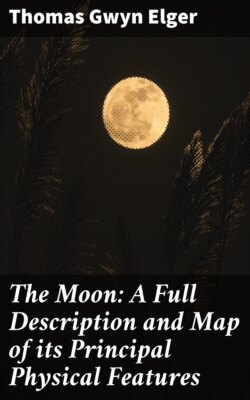Читать книгу The Moon: A Full Description and Map of its Principal Physical Features - Thomas Gwyn Elger - Страница 3
На сайте Литреса книга снята с продажи.
PREFACE
ОглавлениеThis book and the accompanying map is chiefly intended for the use of lunar observers, but it is hoped it may be acceptable to many who, though they cannot strictly be thus described, take a general interest in astronomy.
The increasing number of those who possess astronomical telescopes, and devote more or less of their leisure in following some particular line of research, is shown by the great success in recent years of societies, such as the British Astronomical Association with its several branches, the Astronomical Society of the Pacific, and similar institutions in various parts of the world. These societies are not only doing much in popularising the sublimest of the sciences, but are the means of developing and organising the capabilities of their members by discouraging aimless and desultory observations, and by pointing out how individual effort may be utilised and made of permanent value in almost every department of astronomy.
The work of the astronomer, like that of the votary of almost every other science, is becoming every year more and more specialised; and among its manifold subdivisions, the study of the physical features of the moon is undoubtedly increasing in popularity and importance. To those who are pursuing such observations, it is believed that this book will be a useful companion to the telescope, and convenient for reference.
Great care has been taken in the preparation of the map, which, so far as the positions of the various objects represented are concerned, is based on the last edition of Beer and Madler's chart, and on the more recent and much larger and elaborate map of Schmidt; while as regards the shape and details of most of the formations, the author's drawings and a large number of photographs have been utilised. Even on so small a scale as eighteen inches to the moon's diameter, more detail might have been inserted, but this, at the expense of distinctness, would have detracted from the value of the map for handy reference in the usually dim light of the observatory, without adding to its utility in other ways. Every named formation is prominently shown; and most other features of interest, including the principal rill-systems, are represented, though, as regards these, no attempt is made to indicate all their manifold details and ramifications, which, to do effectually, would in very many instances require a map on a much larger scale than any that has yet appeared.
The insertion of meridian lines and parallels of latitude at every ten degrees, and the substitution of names for reference numbers, will add to the usefulness of the map.
With respect to the text, a large proportion of the objects in the Catalogue and in the Appendix have been observed and drawn by the author many times during the last thirty years, and described in The Observatory and other publications. He has had, besides, the advantage of consulting excellent sketches by Mr. W.H. MAW, F.R.A.S., Dr. SHELDON, F.R.A.S., Mr. A. MEE, F.R.A.S., Mr. G.P. HALLOWES, F.R.A.S., Dr. SMART, F.R.A.S., Mr. T. GORDON, F.R.A.S., Mr. G.T. DAVIS, Herr BRENNER, Herr KRIEGER, Mr. H. CORDER, and other members of the British Astronomical Association. Through the courtesy of Professor HOLDEN, Director of the Lick Observatory, and M. PRINZ, of the Royal Observatory of Brussels, many beautiful photographs and direct photographic enlargements have been available, as have also the exquisite heliogravures received by the author from Dr. L. WEINEK, Director of the Imperial Observatory of Prague, and the admirable examples of the photographic work of MM. PAUL and PROSPER HENRY of the Paris Observatory, which are occasionally published in Knowledge. The numerous representations of lunar objects which have appeared from time to time in that storehouse of astronomical information, The English Mechanic, and the invaluable notes in "Celestial Objects for Common Telescopes," and in various periodicals, by the late REV. PREBENDARY WEBB, to whom Selenography and Astronomy generally owe so much, have also been consulted.
As a rule, all the more prominent and important features are described, though very frequently interesting details are referred to which, from their minuteness, could not be shown in the map. The measurements (given in round numbers) are derived in most instances from NEISON'S (Nevill) "Moon," though occasionally those in the introduction to Schmidt's chart are adopted.
